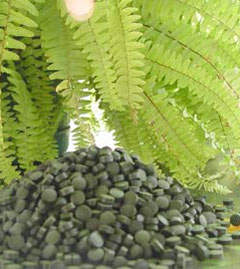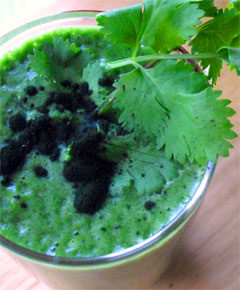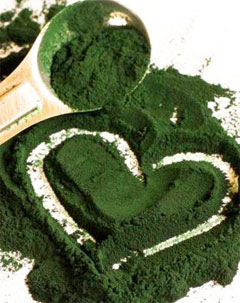|
|
Spirulina: A Miracle High-Protein Super Food

Spirulina is a natural �algae� (cyanbacteria) powder that is incredible high
in protein and nutrients. When harvested correctly from non-contaminated ponds
and bodies of water, it is one of the most potent nutrient sources available.
It is largely made up of protein and essential amino acids, and I typically
recommend it to clients who decide to remain vegetarian for its high natural
iron content. It is often touted for its high B-12 content, though there is a
lot of debate about if this particular form is a complete and absorbable form of
B-12 and I don�t recommend it completely in place of animal products. The high
concentration of protein and iron also makes it ideal during pregnancy, after
surgery, or anytime the immune system needs a boost.
Health benefits of Spirulina
-
Spirulina is 65% protein and amino acids including the essential fatty acid
gamma linolenic acid (GLA) which has gotten a lot of attention for its
anti-inflammatory properties, especially when taken with other quality Omega-3
supplements like Fermented Cod Liver Oil. (I suspect that the benefits of GLA in
Spirulina are even more than what the studies have found since these studies
often use vegetable oils for their GLA source, and the other inflammatory
compounds in vegetable oils can interfere with the anti-inflammatory ability.)
It contains all essential amino acids.
-
Spirulina contains Omega 3-,6 and 9s and is especially high in Omega-3s.
-
Spirulina is extremely high in Chlorophyll, which helps remove toxins from the
blood and boost the immune system.
-
Spirulina has a very high concentration of bio-available iron and is excellent
during pregnancy and for those with anemia and will not cause constipation.
-
Spirulina is a great source of other nutrients including : Spirulina contains
vitamins B-1(thiamine), B-2 (riboflavin), B-3(nicotinamide), B-6 (pyridoxine),
B-9 (folic acid), vitamin C, vitamin D, vitamin A and vitamin E.
-
It is also a source of potassium, calcium, chromium, copper, iron, magnesium,
manganese, phosphorus, selenium, sodium and zinc. Spirulina contains many
pigments which may be beneficial and bioavailable.
-
This Spirulina (from Mountain Rose Herbs) was tested be an independent
laboratory and found to have an ORAC (Oxygen Radical Absorbance Capacity) of
over 24,000 which is 4x the ORAC score of blueberries. The ORAC score is
generally used to measure antioxidant ability and concentration in different
foods.
-
Spirulina is also incredibly high in calcium with over 26 times the calcium in
milk, making it excellent for children, the elderly and during pregnancy.
-
Some research has suggested that Spirulina may be helpful in allergies and
allergic reactions.
-
Spirulina�s phosphorus content makes it helpful as part of a tooth
remineralization regimen.
-
Emerging evidence suggests that it binds with radioactive isotopes and may be
useful for radioactivity exposure or radiation therapy.
-
The protein in Spirulina is highly usable and has a net protein utilization rate
of between 50-61%.
-
Spirulina can bind with heavy metals in the body and help remove them.
-
Spirulina can increase fat burning during exercise.
More health benefits
Immune Support
 A number of animal and test tube studies suggest that spirulina increases
production of antibodies, infection-fighting proteins, and other cells that
improve immunity and help ward off infection and chronic illnesses such as
cancer. However, it has not been tested in people. In one clinical trial that
involved humans, another type of blue-green algae called chlorella did not boost
the immune response to flu vaccine. A number of animal and test tube studies suggest that spirulina increases
production of antibodies, infection-fighting proteins, and other cells that
improve immunity and help ward off infection and chronic illnesses such as
cancer. However, it has not been tested in people. In one clinical trial that
involved humans, another type of blue-green algae called chlorella did not boost
the immune response to flu vaccine.
Protein Supplement
Amino acids make up 62% of spirulina. Because it is a rich source of protein and
other nutrients, spirulina has been used as a nutritional supplement. However,
although spirulina contains a certain level of protein, you would need to take
very large quantities to see any effect. Other sources of protein, such as nuts,
legumes, whole grains, and meat, provide protein in smaller servings.
Allergic Reactions
Animal and test tube studies suggest that spirulina may protect against allergic
reactions by stopping the release of histamines, substances that contribute to
allergy symptoms, such as a runny nose, watery eyes, hives, and soft-tissue
swelling. But whether these preliminary studies will help people with allergies
is not known.
Antibiotic-related Illnesses
Although antibiotics destroy unwanted organisms in the body, they may also kill
"good" bacteria called probiotics, such as Lactobacillus acidophilus. This can
cause diarrhea. In test tubes, spirulina has boosted the growth of L.
acidophilus and other probiotics. More research is needed to determine whether
spirulina will have the same effect in people.
Infection
Test tube studies suggest that spirulina has activity against herpes, influenza,
and HIV. But researchers don�t know whether it would also work in people.
Oral Cancer
In one placebo-controlled study, taking spirulina seemed to reduce a
precancerous lesion known as leukoplasia in people who chewed tobacco. Lesions
were more likely to go away in the spirulina group than in the placebo group.
More research in this area is needed.
Liver Disorders
Preliminary evidence suggests that spirulina may help protect against liver
damage and cirrhosis (liver failure) in people with chronic hepatitis. Without
more research, however, it is impossible to say whether spirulina offers any
real benefit.
Spirulina is a cyanobacterium that can be consumed by humans and animals and is
made primarily from two species of cyanobacteria: Arthrospira platensis and
Arthrospira maxima. Arthrospira is cultivated worldwide; used as a dietary
supplement as well as a whole food; and is available in tablet, flake and powder
form. It is also used as a feed supplement in the aquaculture, aquarium and
poultry industries.
Spirulina was a food source for the Aztecs and other Mesoamericans until the
16th century; the harvest from Lake Texcoco and subsequent sale as cakes were
described by one of Cort�s' soldiers. The Aztecs called it "techuitlatl".
Spirulina was found in abundance at Lake Texcoco by French researchers in the
1960s, but there is no reference to its use by the Aztecs as a daily food source
after the 16th century, probably due to the draining of the surrounding lakes
for agricultural and urban development. The first large-scale spirulina
production plant, run by Sosa Texcoco, was established there in the early 1970s.
Spirulina has also been traditionally harvested in Chad. It is dried into cakes
called dih�, which are used to make broths for meals, and also sold in markets.
The spirulina is harvested from small lakes and ponds around Lake Chad.
Nutrient and vitamin content in Spirulina
Protein
 Dried spirulina contains about 60% (51�71%) protein. It is a complete protein
containing all essential amino acids, though with reduced amounts of methionine,
cysteine and lysine when compared to the proteins of meat, eggs and milk. It is,
however, superior to typical plant protein, such as that from legumes. The U.S.
National Library of Medicine said that spirulina was no better than milk or meat
as a protein source, and was approximately 30 times more expensive per gram. Dried spirulina contains about 60% (51�71%) protein. It is a complete protein
containing all essential amino acids, though with reduced amounts of methionine,
cysteine and lysine when compared to the proteins of meat, eggs and milk. It is,
however, superior to typical plant protein, such as that from legumes. The U.S.
National Library of Medicine said that spirulina was no better than milk or meat
as a protein source, and was approximately 30 times more expensive per gram.
Other nutrients
Spirulina's lipid content is about 7% by weight, and is rich in gamma-linolenic
acid (GLA), and also provides alpha-linolenic acid (ALA), linoleic acid (LA),
stearidonic acid (SDA), eicosapentaenoic acid (EPA), docosahexaenoic acid (DHA)
and arachidonic acid (AA). Spirulina contains vitamins B1 (thiamine), B2
(riboflavin), B3 (nicotinamide), B6 (pyridoxine), B9 (folic acid), vitamin C,
vitamin D, vitamin A and vitamin E. It is also a source of potassium, calcium,
chromium, copper, iron, magnesium, manganese, phosphorus, selenium, sodium and
zinc. Spirulina contains many pigments which may be beneficial and bioavailable,
including beta-carotene, zeaxanthin, chlorophyll-a, xanthophyll, echinenone,
myxoxanthophyll, canthaxanthin, diatoxanthin, 3'-hydroxyechinenone,
beta-cryptoxanthin and oscillaxanthin, plus the phycobiliproteins c-phycocyanin
and allophycocyanin.
Vitamin B12 controversy
Spirulina is not considered to be a reliable source of Vitamin B12. Spirulina
supplements contain predominantly pseudovitamin B12, which is biologically
inactive in humans. Companies which grow and market spirulina have claimed it to
be a significant source of B12 on the basis of alternative, unpublished assays,
although their claims are not accepted by independent scientific organizations.
The American Dietetic Association and Dietitians of Canada in their position
paper on vegetarian diets state that spirulina cannot be counted on as a
reliable source of active vitamin B12. The medical literature similarly advises
that spirulina is unsuitable as a source of B12
Possible health benefits and risks of spirulina
Toxicological studies
Toxicological studies of the effects of spirulina consumption on humans and
animals, including feeding as much as 800mg/kg, and replacing up to 60% of
protein intake with spirulina, have shown no toxic effects. Fertility,
teratogenicity, peri- and post-natal, and multi-generational studies on animals
also have found no adverse effects from spirulina consumption. Spirulina intake
has also been found to prevent damage caused by toxins affecting the heart,
liver, kidneys, neurons, eyes, ovaries, DNA, and testicles. In a 2009 study, 550
malnourished children were fed up to 10 g/day of spirulina powder, with no
adverse effects. Dozens of human clinical studies have similarly shown no
harmful effects to spirulina supplementation.
Quality-related safety issues
Spirulina is a form of cyanobacterium, some of which are known to produce toxins
such as microcystins, BMAA, and others. Some spirulina supplements have been
found to be contaminated with microcystins, albeit at levels below the limit set
by the Oregon Health Department. Microcystins can cause gastrointestinal
disturbances and, in the long term, liver cancer. The effects of chronic
exposure to even very low levels of microcystins are of concern, because of the
potential risk of cancer.
These toxic compounds are not produced by spirulina itself, but may occur as a
result of contamination of spirulina batches with other, toxin-producing,
blue-green algae. Because spirulina is considered a dietary supplement in the
U.S., there is no active, industry-wide regulation of its production and no
enforced safety standards for its production or purity. The U.S. National
Institutes of Health describes spirulina supplements as "possibly safe",
provided they are free of microcystin contamination, but "likely unsafe"
(especially for children) if contaminated. Given the lack of regulatory
standards in the U.S., some public-health researchers have raised the concern
that consumers cannot be certain that spirulina and other blue-green algae
supplements are free of contamination.
Heavy-metal contamination of spirulina supplements has also raised concern. The
Chinese State Food and Drug Administration reported that lead, mercury, and
arsenic contamination was widespread in spirulina supplements marketed in China.
Safety issues for certain target groups
 Due to very high Vitamin K content, patients undergoing anticoagulant treatments
should not change consumption patterns of spirulina without seeking medical
advice to adjust the level of medication accordingly. Due to very high Vitamin K content, patients undergoing anticoagulant treatments
should not change consumption patterns of spirulina without seeking medical
advice to adjust the level of medication accordingly.
Like all protein-rich foods, spirulina contains the essential amino acid
phenylalanine (2.6-4.1 g/100 g), which should be avoided by people who have
phenylketonuria, a rare genetic disorder that prevents the body from
metabolizing phenylalanine, which then builds up in the brain, causing damage.
In vitro research
The primary active component of spirulina is Phycocyanobilin, which constitutes
about 1% of Spirulina by weight. This compound inhibits NADPH oxidase. Spirulina
has been studied in vitro against HIV, as an iron-chelating agent, and as a
radioprotective agent. Animal studies have evaluated spirulina in the prevention
of chemotherapy-induced heart damage, stroke recovery, age-related declines in
memory, diabetes mellitus, in amyotrophic lateral sclerosis, and in rodent
models of hay fever.
Human research
In humans, small studies have been undertaken evaluating spirulina in
undernourished children, as a treatment for the cosmetic aspects of arsenic
poisoning, in hay fever and allergic rhinitis, in arthritis, in hyperlipidemia
and hypertension, and as a means of improving exercise tolerance. At present,
these studies are considered preliminary. According to the U.S. National
Institutes of Health, at present there is insufficient scientific evidence to
recommend spirulina supplementation for any human condition, and more research
is needed to clarify its benefits, if any.
Video
Dated 16 November 2013
|
|
|
|
|









